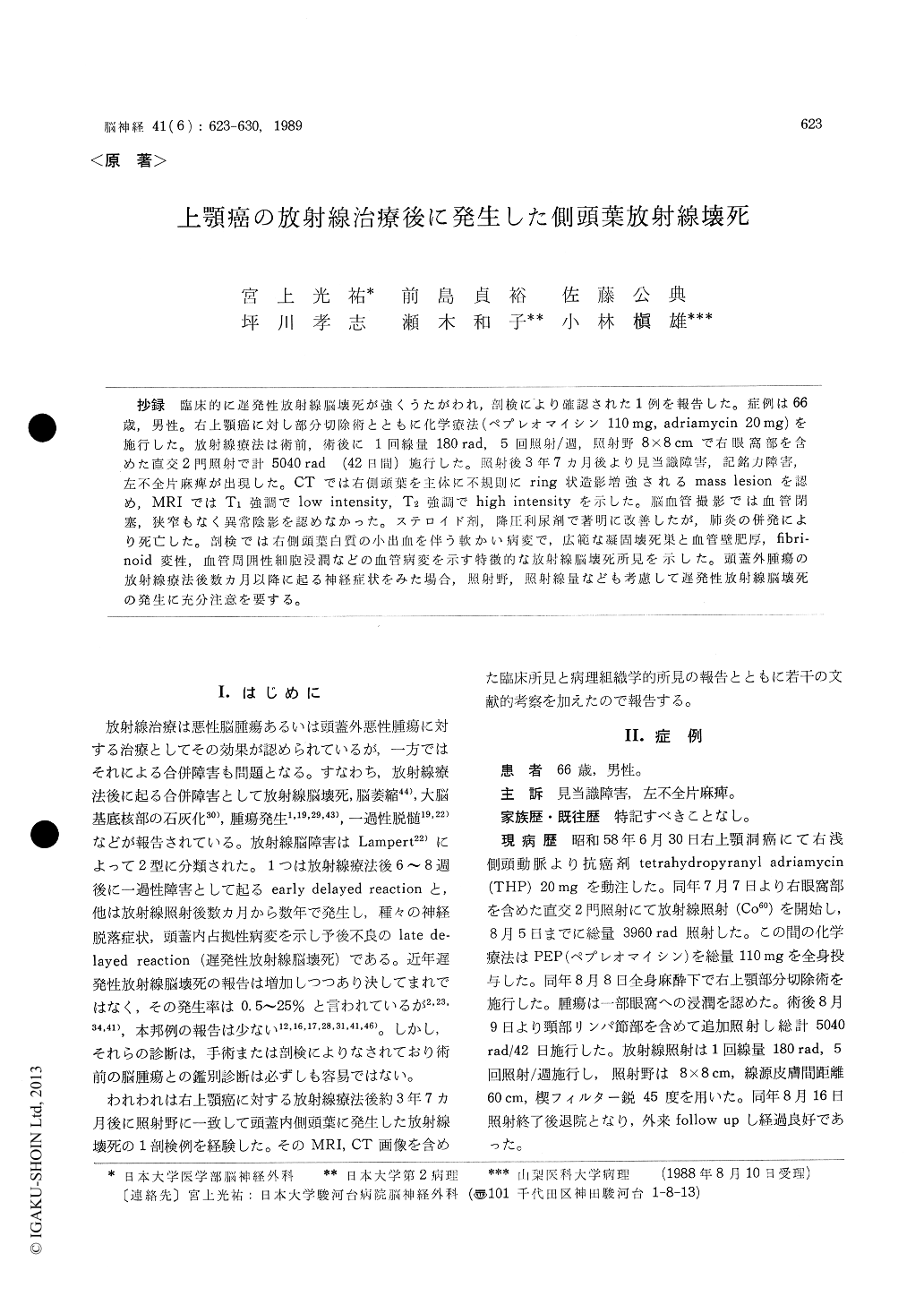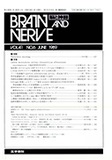Japanese
English
- 有料閲覧
- Abstract 文献概要
- 1ページ目 Look Inside
抄録 臨床的に遅発性放射線脳壊死が強くうたがわれ,剖検により確認された1例を報告した。症例は66歳,男性。右上顎癌に対し部分切除術とともに化学療法(ペプレオマイシン110mg, adriamycin 20mg)を施行した。放射線療法は術前,術後に1回線績180rad,5回照射/週,照射野8×8cmで右眼窩部を含めた直交2門照射で計5040rad (42日間)施行した。照射後3年7カ月後より見当識障害,記銘力障害,左不全片麻痺が出現した。CTでは右側頭葉を主体に不規則にring状造影増強されるmass lesionを認め,MRIではT1強調でlow intensity, T2強調でhigh intensityを示した。脳血管撮影では血管閉塞,狭窄もなく異常陰影を認めなかった。ステロイド剤,降圧利尿剤で著明に改善したが,肺炎の併発により死亡した。剖検では右側頭葉白質の小出血を伴う軟かい病変で,広範な凝固壊死巣と血管壁肥厚,fbri-noid変性,血管周囲性細胞浸潤などの血管病変を示す特徴的な放射線脳壊死所見を示した。頭蓋外腫瘍の放射線療法後数カ月以降に起る神経症状をみた場合,照射野,照射線壷なども考慮して遅発性放射線脳壊死の発生に充分注意を要する。
A case of delayed radiation necrosis following radiation therapy for maxillary carcinoma was reported. The diagnosis of this case for the radia-tion necrosis was clinically suggestive and estab-lished by the pathological findings of autopsy. This 66 year-old man had been treated by the partial resection for the right maxillary carcinoma with chemotherapy (pepleomycin 110 mg, adria-mycin 20 mg). Pre- and postoperatively total dose of 5040 rads were irradiated with cobalt therapy during 42 days at a dose of 180 rads and 5 times in a week through two ports at 8 x 8 cm field including right orbital region. Three years 7 months after radiation therapy he complained of dysorient-ation, recent memory disturbance and slight left hemiparesis. On enhanced CT irregular ring en-hanced mass lesion was seen in left temporal lobe inside the radiation field with extensive low den-sity over temporal lobe on plain CT. MR imaging demonstrated that T 1-weighted spin echo images with a 50-msec repetition time (TR) and 22-msec echo time (TE) had irregular low signal intensity and extensive high signal intensity combined with partially low intensity in the central area on T 2weighted spin echo images with 2300 msec TR and 100 msec TR. There were not appeared vascular obstruction and stenosis on right carotid angio-gram. He improved remarkably on clinical symp-toms and CT by treating of dexamethasone and osmotic diuretics, but died of pneumonia. Autopsy revealed characteristic features of delayed radia-tion necrosis in the right temporal lobe which had extensive coagulation necrosis and the vascular change with thickening and fibrinoid degenerationof the blood vessels and perivascular round cell infiltration or hemorrhage.
The delayed onset of neurologic symptoms and signs of a mass lesion in the brain following ir-radiation for the extracranial malignant tumor should lead to the consideration of radiation ne-crosis. Neuroradiological findings including CT, MR image and PET may be important on the clini-cal diagnosis for that.

Copyright © 1989, Igaku-Shoin Ltd. All rights reserved.


